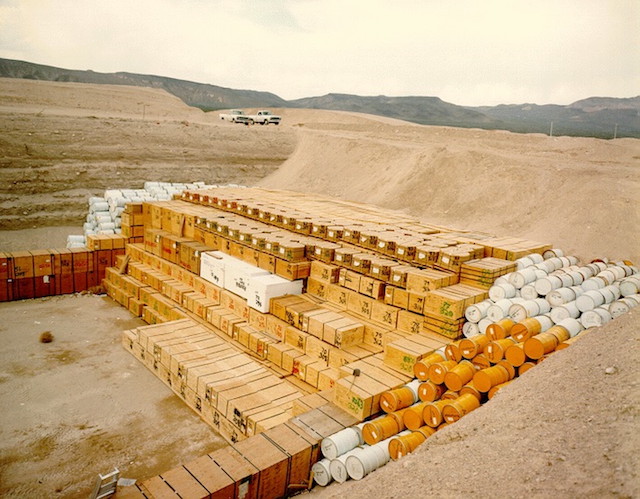In one sense, nuclear materials direct our attention to the vibrancy and reactivity of all material life. Nuclear elements such as uranium, radium, thorium, and plutonium regularly leak electrons during the process known as radioactive decay or nuclear disintegration, intra-acting and transforming themselves and others in unpredictable ways (see Barad 2007).
At the same time, nuclear events and places are also often framed as ruptures, whether in the form of nuclear weapons detonations, nuclear disaster inquiries, the creation of new nuclear power or waste projects, or the founding of new mines to unearth nuclear elements. From this perspective, nuclear events such as the 2011 Fukushima Daiichi nuclear disaster somehow signal a break, implying that before, the Fukushima region was untouched by disruptive energies and effects of the nuclear. A nuclear actor enters, causes a break, and leaves worlds permanently altered.
As historian and anthropologist Gabrielle Hecht (2014) explains, forms of “nuclearity”—the technopolitical regimes that emerge around things deemed “nuclear”—are not given, uniform, or stable. They emerge, shift, and react. Compare, for example, the different political histories and interpretations placed around investments in nuclear energy and nuclear medicine, or even their respective waste products.
This upcoming series brings together three scholars—Tomoki Fukui, Maxime Polleri, and Kirsty Howey—whose ethnographic research focuses on life as it is entangled with the ruptures and reactions of nuclear materials, events, and places. In the series, they discuss how their work brings into question common understandings of nuclear events. Against common representations of such events as breaks or ruptures, these scholars show they are instead continuous within longer-term histories of race, science, gender, and labor.
How does attention to the materialities of radiation give us new insights into the reactive and disruptive systems of power—such as imperialism and settler-colonialism—that distribute and disperse nuclear things in our world? How can we both articulate the very real impacts and contaminations of nuclear “events” and, at the same time, stay attuned to the transformative energies of colonial power and epistemologies?

Low-level waste storage pit at the Nevada National Security Site. (Anon, unknown date)
Tomoki Fukui reveals the fraught reproductive politics of post-Fukushima Japan, taking up an interlocutor’s description of anti-irradiation efforts as hentai, and the inference that Japanese mothers who take issue with nuclear reconstruction in late-capitalist Japan are perverse and aberrant. As Fukui describes, the contemporary moment contains traces of imperial logics that seek to control reproduction, in part by stigmatizing those imagined to “lack productivity.”
State discourses position those who take issue with government radiation standards and policies as not only ignorant and ill-informed, as might be expected, but also as discriminatory and harmful to women. This achieves a “fascist inversion of violence,” Fukui argues, with targets of state violence simultaneously repositioned as sources of harm and healing, their maternal identities weaponized to both discredit their concerns and enroll them in making the national polity “whole” again. Citing scholars such as Lou Cornum and M Ty, Fukui asks how such a situation calls for us to deform (or decay?) normative forms such as “citizens” rather than make recourse to them.
Maxime Polleri places in conversation common nuclear narratives of victimhood and damaged bodies with post victimhood approaches to research (see also Polleri 2019). He cautions us against elevating discourses of resistance over other modes of relating to and even accommodating radiation.
In a striking contrast to Fukui’s research on mothers of young children seeking to leave contaminated towns, Polleri shifts our attention to older male farmers willingly returning to irradiated regions to rejuvenate land and crops.
This contrast reveals tensions between the gendered divisions of production and reproduction. It also spotlights the importance of age, not only as a sociological category containing a set of differentiated generational norms, but crucially, as a figure in which biology, life-course, and notions of life itself meet and diverge. The real and perceived risk to radiation exposure and exposure dose rates varies between smaller and larger bodies, between young and old cells, and between pre-reproductive, reproductive, and post-reproductive bodies.
Kirsty Howey explores the bureaucratic afterlives of a yellowcake mine within wide extractive economies and legal apparatuses in Australia. She cautions us from seeing the dangerous specter of radioactivity within nuclear afterlives as the primary figure of its potency. For it is as much the mundane bureaucratic pathways and protocols that a uranium mine carves out, in the benevolent language of contract, which go on to shape and limit the opportunities for Indigenous communities to negotiate with the state (see also Howey 2020).
Howey also stretches the scales of time and space that nuclear technologies and their biological effects normally make visible. The Fukushima disaster can thus be traced back to Australia and the bureaucratic life of yellowcake. Such an approach renders explicit the social links between nuclear affected communities and the chain of exchange and causation upon which nuclear injury depends. Perhaps, it suggests new alliances upon which global modes of social action might grow.
Mattering, Barad (2007) argues, “is simultaneously a matter of substance and significance” (3). In the mattering of materials, such as nuclear isotopes, we might find “an invitation to live justly” if we are responsive and responsible (xi). These three scholars’ ethnographic research pursues this invitation, revealing how nuclear materials are embedded and sedimented, remarkable and mundane, to give us new insight into nuclearities as they emerge, shift, and react in curious ways.
Stay tuned in the upcoming weeks for the three individual pieces!
References
Barad, Karen. 2007. Meeting the Universe Halfway: Quantum Physics and the Entanglement of Matter and Meaning. Durham, NC: Duke University Press.
Hecht, Gabrielle. 2014. Being Nuclear: Africans and the Global Uranium Trade. Cambridge, MA: MIT Press.
Howey, Kirsty. 2020. “The Ranger Uranium Mine Agreement Revisited: Spacetimes of Indigenous Agreement-making in Australia.” Transformations 33.
Polleri, Maxime. 2019. “Conflictual Collaboration: Citizen Science and the Governance of Radioactive Contamination after the Fukushima Nuclear Disaster.” American Ethnologist 46 (2): 214-226.
